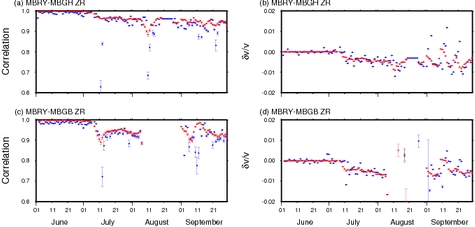Lava Dome Collapse Detected Using Passive Seismic Interferometry
Recent research that shows how information about the Earth can be extracted from background noise recorded at pairs of seismometers, as if one were a source and the other a receiver, an approach commonly known as seismic interferometry. This can be applied to continuously monitor small changes in the properties of the subsurface over a period of time. Brenguier et al (2008) link very small changes in seismic velocity to pre-eruptive inflation of the volcanic edifice at Piton de la Fournaise volcano.
The collapse of the lava dome at the Soufriere Hills Volcano on Montserrat in July 2003 is the largest recorded in historical times. We use noise correlation Green's functions to measure the changes in seismic properties that resulted from this collapse. Following the collapse, there is a clear decorrelation and phase shift in the Green's functions corresponding to a change in velocity of approximately 0.5% that can be interpreted in terms of the unloading of the lava dome.

Continuous three component seismic data recorded at two pairs of stations were cross-correlated to retrieve three-component Green's functions along two paths that intersect the volcanic edifice before and after the dome collapse. Particle motion analysis shows that the Green's functions are dominated by Rayleigh waves and are consistent with the expected Green's tensor for a vertical point force source at one station recorded by a three-component receiver at the other.


- A Comparison of the Folkestone and Market Rasen Earthquakes
- Revised Seismic Hazard Maps for the UK
- Seismogenesis and State of Stress in the UK
- Monitoring Volcanic Eruptions Using Interferometry
- Particular events
- Are yesterday's earthquakes tomorrow's disasters?
- Creating 'virtual seismometers' deep inside the Earth
- Fault line living
- Is earthquake activity related to the Moon or Sun?
- Is earthquake activity increasing?

- Monitoring Montserrat's volcano - past, present and future
- Montserrat Volcano Observatory
- Baptie, 2010. Geophys. Res. Lett.,37, L00E10
- Towards forecasting volcanic eruptions using seismic noise Brenguier et al, 2008, Nature Geoscience, 1, 126-130
- Seismic interferometry - turning noise into signal. Curtis et al, 2006. The Leading Edge, 25,9, 1082-1092.

